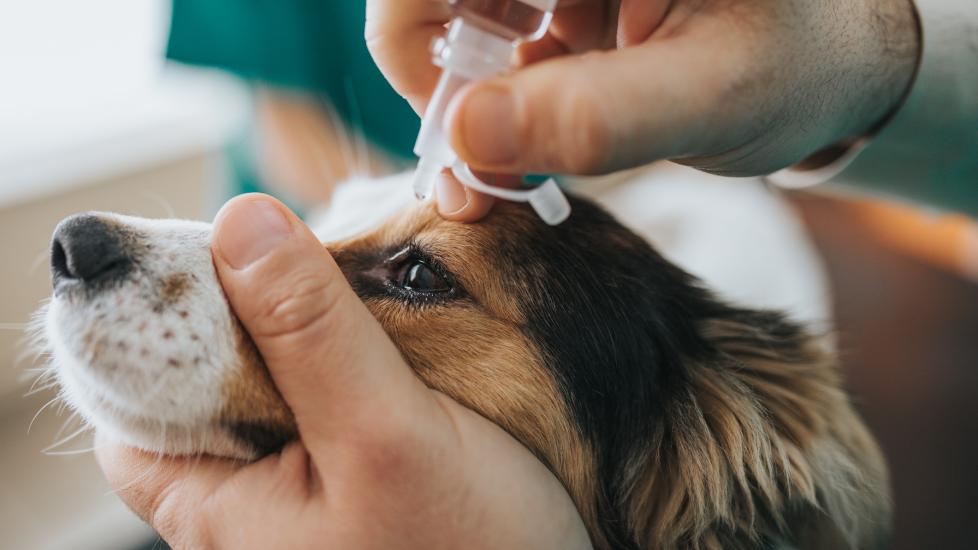Primary Lens Luxation in Dogs
skynesher/E+ via Getty Images
What Is Primary Lens Luxation in Dogs?
The lens is a small, clear disc inside the eye that focuses light on the retina to help your dog see. It’s suspended in place by small ligaments called zonules. When these ligaments break down, it can cause the lens to fall or “luxate” out of its normal position.
Lens luxation either can be the primary problem in the eye (called primary lens luxation), or it may occur secondary to another condition inside the eye (called secondary lens luxation).
The lens can either fall forward or backward out of its normal position. When the lens falls forward, it is called anterior luxation. When it falls backward, it is called posterior luxation.
It’s more serious when the lens falls forward in the eye, as anterior lens luxation can block the flow of normal fluid out of the eye. This causes pressure to build up and results in glaucoma, which is increased pressure inside the eye. Glaucoma is very painful in dogs. The building pressure can also lead to permanent blindness.
Because of this risk, primary lens luxation in dogs is considered a medical emergency. While anterior lens luxation can be incredibly painful and may result in permanent vision loss, it’s not a fatal condition in dogs.
Symptoms of Primary Lens Luxation in Dogs
Symptoms of primary lens luxation in dogs include:
-
Squinting
-
Change in the pupil size or shape
-
White spot in front of the iris (the colored part of the eye)
Causes of Primary Lens Luxation in Dogs
Primary lens luxation occurs when there is weakness and breakdown of the ligaments that hold the lens in place due to an inherited condition, meaning it’s caused by genetics. Secondary lens luxation occurs following a problem within the eye, such as inflammation, glaucoma, cataracts, cancer, or trauma.
Primary lens luxation more commonly occurs in young adulthood when affected dogs are between 3 and 8 years old. This condition is more common in:
How Veterinarians Diagnose Primary Lens Luxation in Dogs
Lens luxation is diagnosed following a complete eye exam, also called an ophthalmic exam. Your veterinarian will look inside your dog’s eye using an instrument called an ophthalmoscope.
Other tests that may be run at your dog’s veterinary office include tonometry and Schirmer’s tear testing (STT).
Tonometry involves using an instrument called a Tono-pen to check your dog’s eye pressure. Schirmer’s tear testing involves using tiny test strips to measure your dog’s tear production. You may be referred to a veterinary ophthalmologist for additional testing, such as an eye ultrasound, to examine the internal structures inside the eye and to discuss repair options.
Share with your veterinarian if your dog has experienced any eye drainage, squinting, or changes in color, and when you first noticed these changes.
Treatment of Primary Lens Luxation in Dogs
Treatment of primary lens luxation is surgical. If caught early enough, your dog can have a lensectomy performed by a veterinary ophthalmologist. In this procedure, a small incision in the eye is made and the lens itself is removed. The incision is then stitched up with tiny sutures that will be absorbed over time.
Dogs who have had this procedure are still able to see; however, they are farsighted without a lens.
There are many possible complications following this surgery, including inflammation, glaucoma, and retinal detachment. Dogs will need lifelong medications post-operatively.
Alternatively, if having the lens removed by a veterinary ophthalmologist is not an option, the painful eye itself can be removed. This surgery is called an enucleation and can be done by your regular veterinarian.
While anterior lens luxation can rapidly lead to glaucoma, pain, and blindness, posterior lens luxation is much less severe. Oftentimes, posterior lens luxation can be managed with topical medications aiming to keep the pupil constricted to prevent the lens from falling forward.
Recovery and Management of Primary Lens Luxation in Dogs
Recovery from surgery usually entails a two-week period of very strict rest.
Your dog may be kept at the veterinary hospital for a few days following the surgery. Once discharged and allowed to come home, it is important to keep their activity levels restricted. During all outdoor time, they should only be leash-walked. Utilize their kennel as much as necessary to prevent running, jumping, and going up or down stairs. A recovery cone will need to be worn to prevent any pawing at the face, and post-operative medications should be given as directed.
If you are struggling to keep your dog’s activity level restricted, talk to your veterinarian about a mild sedative, such as trazodone, to see if it would be a good fit for your pup.
Prevention of Primary Lens Luxation in Dogs
Because primary lens luxation is an inherited condition, the focus of prevention lies on not breeding affected animals.
However, most affected dogs do not have their lens luxate until they are around 3 years of age, and many breeding animals are selected earlier than that. Fortunately, there are genetic tests available to determine if your dog carries the most common gene associated with primary lens luxation, the ADAMST17 gene.
If your dog has experienced primary lens luxation in one eye, it’s common for it to progress to the other eye. Scheduling regular complete eye exams for your dog can aid in early intervention to prevent rapid progression and vision loss in the other eye.
Primary Lens Luxation in Dogs FAQs
What is the cost of lens luxation surgery in dogs?
The cost of removing the lens varies by region, but usually ranges between $1,500 and $4,000.
References
Bobofchak, M. DVM360. Managing disease of the lens-clarification of a cloudy type. (2011)
Cohen & Dockweiler. College of Veterinary Medicine. Cornell University. Primary Lens Luxation. (2024)
Gould, D. et al. National Library of Medicine. ADAMTS17 mutation associated with primary lens luxation is widespread among breeds. (2011)
